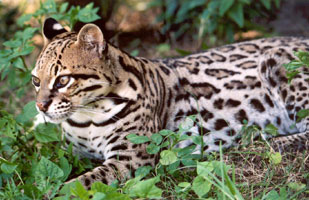In the verdant jungles of Belize, a creature of unmatched elegance prowls silently, its dappled coat blending seamlessly with the shadows. The Ocelot, revered for its beauty and feared for its hunting prowess, epitomizes the wild allure of Central America’s untamed landscapes. With its distinctive spotted fur and agile movements, this enigmatic wild cat holds a significant place in the rich biodiversity of Belize, yet its existence faces challenges in an ever-changing world. Join us as we delve into the realm of the Ocelot, unraveling its secrets, exploring its hunting techniques, and contemplating the conservation efforts crucial for its survival in Belize’s wilderness.
Mysterious Elegance: Unraveling the Ocelot’s Spotted Coat
The Ocelot’s spotted coat is a masterpiece of nature, a symphony of black rosettes and stripes painted upon a background of golden fur. These distinctive markings not only contribute to its exquisite beauty but also serve a vital purpose in its survival. As the Ocelot prowls through the dense foliage of Belize’s forests, its coat becomes a natural camouflage, allowing it to blend seamlessly into its surroundings and evade the keen eyes of potential predators.
Each Ocelot’s coat pattern is unique, much like a fingerprint, making it possible to identify individuals within the species. The size and arrangement of the spots vary, adding to the allure of these elusive cats. The rosettes on their flanks and back mimic the dappled sunlight filtering through the canopy, creating an illusion of depth and movement that confounds onlookers.
Beyond its aesthetic appeal, the Ocelot’s spotted coat plays a crucial role in its hunting strategies. As a solitary and nocturnal hunter, the Ocelot relies on stealth and surprise to capture its prey. Its coat’s camouflage allows it to approach unsuspecting prey, such as rodents, birds, and small mammals, with minimal detection until the final pounce.
Interestingly, the Ocelot’s coat can also reflect its health and genetic diversity. A vibrant and well-defined coat often indicates a healthy individual with access to abundant food sources. Researchers studying Ocelots in Belize use these visual cues to monitor population dynamics and assess the overall well-being of the species in its natural habitat.
Despite the Ocelot’s ability to blend into the shadows, its spotted coat symbolizes the bright spotlight of conservation efforts. As human activities continue to encroach upon wild spaces, preserving the Ocelot’s habitat becomes paramount to safeguarding not just a species, but a symbol of Belize’s natural heritage.
Stealthy Predators: Understanding the Ocelot’s Agile Hunting Techniques
The Ocelot’s sleek and agile physique is finely tuned for the art of hunting in Belize’s diverse ecosystems. As a nocturnal predator, it navigates the darkness with unparalleled grace, relying on a combination of keen senses and strategic maneuvers to secure its next meal.
One of the Ocelot’s remarkable hunting techniques is its ability to stalk prey silently through the undergrowth. Its padded paws cushion each step, muffling any sound that could alert potential quarry. This stealthy approach allows the Ocelot to get within striking distance without betraying its presence, a skill honed over generations of evolution.
When the moment is right, the Ocelot unleashes its lightning-fast reflexes in a burst of speed and precision. With muscles coiled like springs, it launches into a graceful leap, covering significant distances in pursuit of fleeing prey. Its sharp retractable claws and powerful jaws ensure a swift and efficient takedown, delivering a quick and humane end to its hunt.
Despite its prowess as a solitary hunter, the Ocelot is not averse to opportunistic dining. It may scavenge on carrion or steal kills from other predators when the opportunity arises, showcasing its adaptability in the face of fluctuating food availability.
The Ocelot’s hunting repertoire extends beyond terrestrial pursuits. It is also an adept climber, capable of scaling trees with ease in pursuit of arboreal prey such as birds and small primates. This vertical agility adds another dimension to its hunting strategy, expanding the range of potential targets and enhancing its survival in Belize’s diverse habitats.
Understanding the intricacies of the Ocelot’s hunting techniques not only illuminates its role as a top predator but also underscores the delicate balance of ecosystems where it thrives. Conservation efforts must consider not just the Ocelot itself, but also the intricate web of interactions that shape its hunting behaviors and ecological impact.
Conservation Challenges: Preserving the Ocelot’s Habitat in Belize
While the Ocelot’s adaptability and hunting prowess have enabled its survival in Belize’s wilderness for centuries, modern challenges now threaten its existence. Conservationists and researchers face a daunting task as they strive to protect not just the Ocelot, but the intricate ecosystems upon which it depends.
One of the primary conservation challenges for the Ocelot in Belize is habitat loss and fragmentation. Rapid urbanization, agricultural expansion, and infrastructure development encroach upon once-vast stretches of pristine forest, leaving fragmented patches of habitat that hinder the Ocelot’s ability to roam and hunt freely. These fragmented habitats also increase the risk of genetic isolation and reduce the species’ resilience to environmental changes.
Human-wildlife conflict poses another significant threat to Ocelot populations in Belize. As human settlements expand into natural areas, conflicts may arise over livestock predation and perceived threats to human safety. In retaliation, Ocelots may be targeted or trapped, leading to direct population declines and negative perceptions of these wild cats.
Climate change further exacerbates the challenges faced by Ocelots and their habitats. Shifts in temperature and precipitation patterns can alter vegetation dynamics, disrupt prey availability, and increase the frequency of extreme weather events that impact Ocelot survival and reproduction.
Conservation efforts aimed at protecting the Ocelot in Belize must adopt a multi-faceted approach. This includes preserving and restoring critical habitats, establishing wildlife corridors to connect fragmented landscapes, implementing sustainable land-use practices, and fostering coexistence between humans and Ocelots through education and community engagement.
Collaborative initiatives involving government agencies, non-profit organizations, local communities, and international partners are essential for implementing effective conservation strategies. By addressing the root causes of habitat loss, human-wildlife conflict, and climate change, we can secure a brighter future for the Ocelot and ensure that Belize’s natural heritage remains intact for generations to come.
Final Thoughts: Safeguarding Belize’s Ocelot Legacy
As we conclude our exploration into the world of the Ocelot in Belize, it becomes clear that this magnificent feline symbolizes not just the beauty of nature but also the challenges of conservation in a rapidly changing world. The Ocelot’s spotted coat and agile hunting skills serve as a testament to its evolutionary prowess and its crucial role as a top predator in Belize’s ecosystems.
However, the path to preserving the Ocelot’s legacy is fraught with obstacles. Habitat loss, human-wildlife conflict, and climate change cast long shadows over its future. Yet, amidst these challenges, there is hope. Conservation efforts driven by passion, science, and collaboration offer a beacon of light for the Ocelot and other wildlife facing similar threats.
To safeguard Belize’s Ocelot legacy, we must act decisively and with unwavering dedication. Protecting and restoring vital habitats, mitigating human-wildlife conflicts through innovative solutions, and addressing the underlying causes of environmental degradation are paramount. Education and awareness play a pivotal role in fostering a deeper appreciation for the Ocelot’s ecological importance and inspiring collective action.
By coming together as stewards of our natural heritage, we can ensure that future generations inherit a world where the Ocelot’s haunting call still echoes through the jungles of Belize, where its graceful movements continue to captivate hearts, and where its presence serves as a reminder of our shared responsibility to cherish and protect the wonders of the wild.




